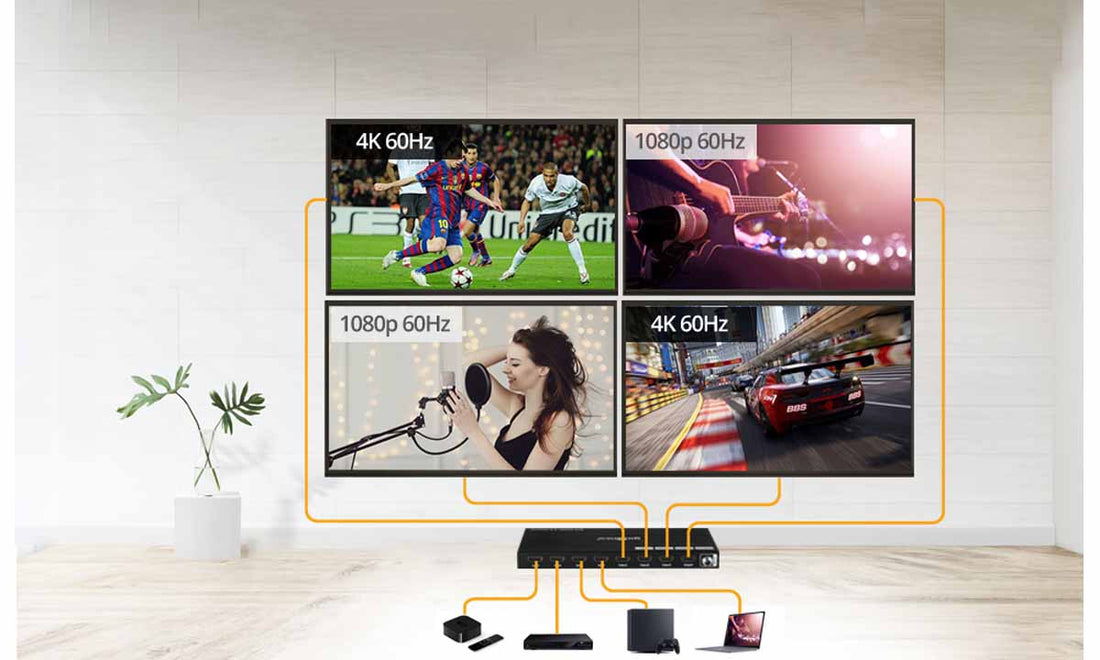
The Ultimate Guide to HDMI Matrix Switchers: Simplify Your AV Setup
Share
Welcome to the ultimate guide to HDMI matrix switchers! In today's digital age, where we have multiple HDMI source devices and display options, managing our audiovisual setup efficiently is essential. HDMI matrix switchers provide the perfect solution by allowing us to connect multiple sources to multiple displays seamlessly. In this comprehensive guide, we will explore everything you need to know about HDMI matrix switchers, their benefits, how they work, and how to choose the right one for your specific needs.
What are HDMI Matrix Switchers?
HDMI matrix switchers are audiovisual devices that allow you to connect multiple HDMI sources (such as Blu-ray players, gaming consoles, set-top boxes, or computers) to multiple HDMI displays (such as TVs, projectors, or monitors) and selectively route the signals between them. it is actually a device that combines the functions of HDMI splitter and HDMI switcher. They offer a convenient way to manage and control the distribution of audio and video signals in complex AV setups.
Unlike HDMI splitters, which duplicate a single HDMI source to multiple displays, HDMI matrix switchers provide the flexibility to switch and route different sources to different displays independently. For example, you can have a setup where you can watch a Blu-ray movie on your living room TV while playing a video game on a separate monitor in another room, all controlled through the HDMI matrix switcher.
HDMI matrix switchers typically come with multiple HDMI inputs and outputs. The number of inputs and outputs varies depending on the model and can range from 2x2 (2 inputs and 2 outputs), 4x2, 4x4 to larger configurations like 8x8 or 16x16. They typically support high-definition video resolutions, including 1080p Full HD and 4K Ultra HD, as well as audio formats such as Dolby Atmos and DTS-HD Master Audio. Some matrix switchers also offer additional features such as audio extraction, support for ARC audio output, and advanced EDID control options.
These devices are commonly used in various environments, including home theaters, conference rooms, classrooms, retail spaces, and digital signage setups. They provide the convenience of centralizing multiple video and audio sources, reducing cable clutter, and simplifying AV installations.
Benefits of HDMI Matrix Switchers:
- Seamless connectivity: Experience hassle-free switching between multiple sources and displays.
- Simplified installations: Reduce cable clutter and optimize space with centralized control.
- Flexibility and convenience: Easily configure and control your AV setup without constant cable swapping.
- Enhanced collaboration: Enable efficient presentations, video conferencing, and collaboration in conference rooms.
- Future-proofing: Support for high resolutions, HDCP compatibility, and advanced features.
How HDMI Matrix Switchers Work:
HDMI matrix switchers are sophisticated audiovisual devices that facilitate the routing of audio and video signals from multiple HDMI sources to multiple HDMI displays. Let's dive into the technical functioning of HDMI matrix switchers and explore key concepts such as input and output ports, EDID, HDCP, and CEC, along with a step-by-step overview of the switching process.
- Input and Output Ports:
- HDMI matrix switchers feature multiple HDMI input ports and output ports. The number of ports varies depending on the model, ranging from a few to dozens.
- Input ports are where you connect your HDMI source devices, such as gaming consoles, Blu-ray players, or cable boxes. Each source device is assigned to a specific input port on the switcher.
- Output ports are where you connect your HDMI display devices, such as TVs, projectors, or monitors. Each display device is assigned to a specific output port on the switcher.
- EDID (Extended Display Identification Data):
- EDID is a communication protocol that allows the HDMI source devices to communicate with connected display devices and obtain information about their capabilities.
- Each display device has an EDID data block that contains information like supported video resolutions, audio formats, aspect ratios, and other display characteristics.
- The HDMI matrix switcher reads the EDID information from the connected display devices to determine the optimal video and audio settings for each output.
- HDCP (High-bandwidth Digital Content Protection):
- HDCP is a content protection protocol designed to prevent unauthorized copying of high-definition content.
- HDMI matrix switchers support HDCP compliance to ensure that encrypted content, such as Blu-ray movies or copy-protected streaming services, can be properly transmitted and displayed on HDCP-compliant displays.
- When a source device sends HDCP-encrypted content, the HDMI matrix switcher ensures that all connected displays support HDCP before transmitting the content.
- CEC (Consumer Electronics Control):
- CEC is a feature available in HDMI-enabled devices that allows for control and command exchange between interconnected devices over the HDMI cable.
- HDMI matrix switchers often support CEC, enabling the control of multiple devices through a single remote control or control system.
- With CEC, you can perform functions like power on/off, volume control, and input switching on compatible devices connected to the HDMI matrix switcher.
Step-by-step overview of the switching process:
- Source Selection: Using a control interface, such as a remote control or control panel, you select the desired source device (e.g., Blu-ray player) connected to a specific input port.
- Destination Selection: You choose the output port associated with the display device (e.g., TV) where you want to view the selected source.
- Signal Routing: The HDMI matrix switcher establishes a connection between the selected source and the chosen display by routing the audio and video signals from the input port to the output port.
- Signal Conversion: If the selected source's video resolution differs from the display's supported resolution, the matrix switcher may perform signal conversion to ensure compatibility and optimal viewing quality.
- EDID Communication: The HDMI matrix switcher communicates with the connected display devices through the EDID protocol to retrieve information about their capabilities and adjust the video and audio settings accordingly.
- HDCP Compliance: If the source device is sending HDCP-encrypted content, the matrix switcher checks the HDCP compliance of the connected displays to ensure proper transmission and display of the content.
- Display Output: The audio and video signals from the selected source are sent to the output port associated with the chosen display device, allowing you to view and hear the content.
- Control and Switching: The HDMI matrix switcher provides control options (remote control, RS-232, IP control) to switch between different source devices and display devices.
By following this step-by-step process, HDMI matrix switchers enable seamless switching and distribution of audio and video signals between multiple sources and displays, providing flexibility and centralized control over your AV setup.
Choosing the Right HDMI Matrix Switcher:
Choosing the right HDMI matrix switcher requires careful consideration of various factors. Here are some key aspects to evaluate when selecting an HDMI matrix switcher:
- Number of Inputs/Outputs: Determine the number of HDMI sources and displays you need to connect. Consider both current and potential future requirements. Ensure that the matrix switcher has sufficient input and output ports to accommodate your devices.
- Resolution Support: Check the supported video resolutions of the matrix switcher. Ensure it can handle the highest resolution of your display devices, such as 1080p Full HD or 4K Ultra HD. Verify if the switcher supports popular video formats like HDR (High Dynamic Range) if that is a requirement.
- EDID Management: EDID management is crucial for proper communication between source devices and displays. Look for a matrix switcher that offers EDID management capabilities, allowing you to customize and optimize video and audio settings based on the capabilities of your displays.
- Audio Extraction Options: If you require audio extraction from specific HDMI sources to route to an external audio system or speakers, ensure that the matrix switcher offers this feature. Some switchers have dedicated audio output ports or audio extraction capabilities to cater to such requirements.
- Control Options: Consider the available control options for the matrix switcher. This could include a remote control, front panel buttons, software-based control systems, or compatibility with control protocols like RS-232 or IP control. Choose a control option that aligns with your preferences and ease of use.
- Compatibility with Existing Devices: Check the compatibility of the matrix switcher with your existing devices, such as gaming consoles, streaming devices, AV receivers, or video conferencing systems. Ensure that the switcher supports the necessary protocols, resolutions, and audio formats required by your devices.
- Budget Considerations: Determine your budget and prioritize the features that are essential for your specific needs. HDMI matrix switchers vary in terms of pricing, and it's important to find the right balance between the required features and affordability. Consider reputable brands that offer a good combination of quality and value.
- User Reviews and Recommendations: Read user reviews and seek recommendations from professionals or AV experts who have experience with HDMI matrix switchers. Their insights can provide valuable information about reliability, ease of installation, performance, and customer support.
By carefully evaluating these factors and aligning them with your specific requirements and budget, you can choose the right HDMI matrix switcher that suits your AV setup and delivers the necessary functionality and performance.
Real-life Use Cases:
HDMI matrix switchers have proven to be valuable solutions in various real-life scenarios. Here are some common use cases and examples of how HDMI matrix switchers have solved AV challenges:
- Home Theaters: HDMI matrix switchers are widely used in home theater setups to centralize and manage multiple HDMI sources and displays. They allow homeowners to switch between devices like Blu-ray players, gaming consoles, media servers, and streaming devices, routing the signals to different TVs or projectors throughout the house. This enables seamless entertainment experiences and eliminates the need for multiple cables and manual connections.
- Conference Rooms: In professional settings, HDMI matrix switchers are essential for conference rooms and meeting spaces. They enable the connection and routing of laptops, presentation systems, video conferencing equipment, and other AV sources to multiple displays or projectors. This ensures easy collaboration, content sharing, and flexible presentation setups, enhancing productivity and communication during meetings.
- Digital Signage: HDMI matrix switchers play a crucial role in managing complex digital signage installations. They allow content managers to distribute multimedia content from different sources to various displays or video walls in retail stores, airports, stadiums, and other commercial environments. The matrix switchers enable dynamic content scheduling, central control, and the ability to display different content on different screens or zones simultaneously.
- Education Environments: HDMI matrix switchers are valuable tools in educational institutions. They enable teachers to connect and switch between different multimedia devices like computers, document cameras, DVD players, and interactive displays. This flexibility enhances the effectiveness of presentations, multimedia lessons, and classroom activities, creating an engaging learning environment.
Testimonials and success stories from individuals and businesses using HDMI matrix switchers further highlight their effectiveness:
These examples illustrate the practical benefits and positive impact of HDMI matrix switchers in diverse AV environments.
Conclusion:
HDMI matrix switchers have revolutionized the way we manage our audiovisual setups. With their ability to simplify connectivity, provide flexibility, and enhance collaboration, they are a valuable addition to any AV system. By understanding the benefits, technical aspects, and choosing the right HDMI matrix switcher, you can optimize your setup and enjoy seamless multimedia experiences.
Remember to consult the user manual and follow manufacturer guidelines for specific models. Whether you're a home theater enthusiast, a business professional, or an AV installer, HDMI matrix switchers are the key to unlocking a world of convenience and versatility in your audiovisual setup.
